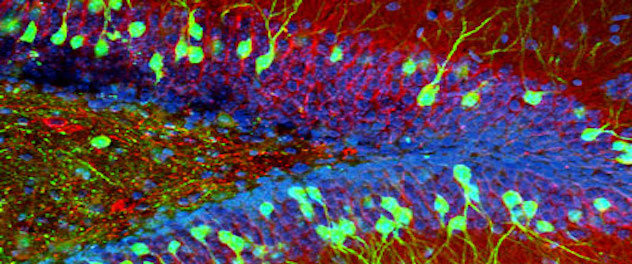 Pinpointing therapeutic strategies for neurodegeneration
Pinpointing therapeutic strategies for neurodegeneration
Dr. Petrucelli's lab seeks to identify new therapeutic options to inhibit nerve degeneration in disorders such as amyotrophic lateral sclerosis, frontotemporal dementia and Alzheimer's disease.
Overview
The Neurodegenerative Diseases Lab seeks to understand and prevent neuronal degeneration and death in diseases characterized by abnormal protein aggregation and defects in RNA metabolism. Our team uses a combination of cell biology, induced pluripotent stem cell technology, transcriptomics and mouse modeling to gain insight into disease mechanisms. We then leverage our findings to develop new therapeutic strategies and clinical tools tailored for these complicated disorders. Our current work focuses on a range of conditions, including Alzheimer's disease, frontotemporal dementia and amyotrophic lateral sclerosis (ALS).
Models and mechanisms
The accumulation of proteins into aggregates is a pathological hallmark of many neurological diseases. This aggregate formation and the mislocalization of the constituent proteins are believed to play key roles in neuronal dysfunction and death. In ALS and frontotemporal dementia, these inclusions are often composed of TAR DNA-binding protein 43 (TDP-43). Other instances of frontotemporal dementia are characterized by the accumulation of the protein tau, which also aggregates in Alzheimer's disease and other dementias.
- Understanding TDP-43 proteinopathies. TDP-43 is a nuclear protein that mislocalizes to the cytoplasm upon aggregation. This mislocalization impairs its endogenous activities, resulting in defects in RNA processing. With the help of our collaborators, we are actively mapping the different RNA defects observed upon TDP-43 knockdown, exploring the contribution of these RNA missplicing events to pathogenesis and determining whether the output of specific missplicing events can be used to develop biomarkers. At the same time, TDP-43-positive ALS and frontotemporal dementia are associated with known genetic lesions in chromosome 9 open reading frame 72 (C9orf72), TANK-binding kinase 1 (TBK1), granulin (GRN) and other genes. Our lab uses cutting-edge techniques to model these different genetic problems in mice.
- Understanding tauopathies. Tau is a microtubule-binding protein that is aberrantly modified under disease conditions, resulting in its polymerization and accumulation into neurofibrillary tangles. Our lab has mapped several modifications that influence the aggregation propensity of tau and its downstream toxic effects. The abnormal tau proteins present in disease tissue also can convert unaffected tau proteins into toxic species. This process is known as seeding. Tau seeding leads to the gradual spread of tau pathology throughout the brain and is a key process in disease progression. The Petrucelli lab uses biochemical techniques, cryogenic electron microscopy and sensitive bioassays to measure and monitor tau seeding activity in cells and patient tissue.
The quest for powerful biomarkers
Biomarkers are factors that are used as indicators of the disease state. They can help diagnose specific conditions, provide insight into disease progression in a person or indicate whether a new treatment is effective. Unfortunately, many of the diseases studied in our lab lack adequate biomarkers, which, in turn, hinders the development and testing of new therapeutics.
Drawing from our mechanistic studies, our lab seeks to identify biological factors that can potentially be used as pathogenic readouts. These factors could be proteins produced during the course of the disease, byproducts of a degenerative process, conformation changes or modification of a given factor, or a myriad other quantifiable outcomes. We then develop sensitive, high-throughput assays to quantify the levels of each potential biomarker in patient samples and test whether these levels can be of diagnostic or prognostic value.